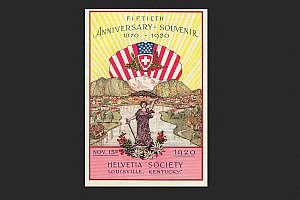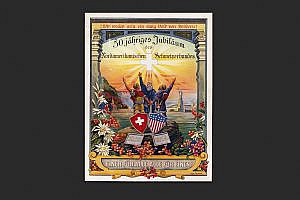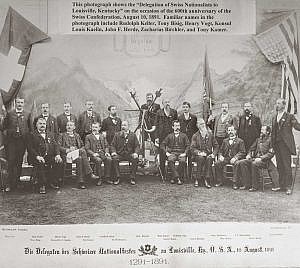Swiss associations in Louisville have a long tradition. The oldest called the "Grütli Verein" was founded in 1850 by 26 Swiss immigrants and named after the "Rütli Meadow" on Lake Lucerne where – thus claims the myth – the Swiss Confederacy was founded. The association's archives contain not only large protocol books of the early years but also documents such as membership lists, statutes, and commemorative publications. Perusing the archive materials, one quickly discovers the use of the strongest symbols of the Swiss past that had been taken along from the old country and seemed to have been especially important in the new. The printed materials seem filled with excerpts from the Federal Charter of 1291, with inserted scenic pictures of mountains as well as with representations of Swiss mythic heroes such as William Tell or Arnold von Winkelried. An especially impressive picture shows three Confederates – an old, middle aged, and young peasant – who swear an oath between the chapel honoring William Tell on Lake Lucerne and New York's Statue of Liberty.
The Grütli Association was eventually joined by some other societies, among them the "Swiss Helvetia Society" founded in 1870, the "Swiss Charity Society" in 1885, and the "Swiss Ladies Society" in 1930. There were others such as a sharpshooter club, established in 1887, and at least two singing groups, the "Alpenrösli", founded in 1878, and the "Edelweiss". In 1887 already there were efforts made to merge all Swiss associations. But the religious and political differences between them were considered too great, as the commemorative publication of the "Gruetli Helvetia Society" of 2000 observed, and nothing came of it. The various groups were pursuing goals that were too diverse. The "Swiss Charity Society", for instance, lent money to prospective Swiss emigrants who lacked the necessary means for the move, and it also supported them financially at their start in Louisville. The "Grütli Verein" and the "Helvetia Society", however, strove to strengthen the bonds between Swiss already settled in Louisville. Thus the first article of the Statutes of the "Grütli Verein" stated: This association aims to create a stronger bond of harmony and friendship among local Swiss, to provide assistance to those who have fallen ill, and in case of death to help the widowed and orphaned with word and deed; further also to nurture love for, and loyalty toward, the old fatherland and to promote respect for the Swiss nation in our new homeland."
Membership was strictly regulated in that only men between the age of 18 and 45 who resided in Jefferson County were admitted. Members, the Statues explained, had to be of "good moral character" and be judged to be "mentally and physically healthy". Before being admitted, candidates had to be examined by a physician who was chosen by the association. Admission occurred by secret ballot. Each voting member was allowed to deposit a white or a black ball into the voting box. If there were more than three black balls, a candidate was rejected without further explanation and could not re-apply for a full year.
In the "Grütli Verein", if less in the "Helvetia Society", there was a strong presence of men from Canton Schwyz. Especially men from Einsiedeln were far more represented than one would expect considering their numbers in Louisville's Swiss community. In 1921, for instance, some two thirds, that is, 79 of 123 members, were from Canton Schwyz, most of them natives of Einsiedeln, and four of the eight honorary members had been born there.
About 1920 the "Grütli Verein" and the "Helvetia Society" together counted some 260 members. They were certainly a minority among all the Louisville Swiss. But the associations played nevertheless an important role in the Swiss community. By the mid-twentieth century their task was less to provide financial support for members in distress than to organize social events. Many still remember for instance the annual "Swiss Picnic" or the dances held in the "Swiss Hall", the center of things Swiss in Louisville from 1926 until 1993 when the property was sold. In the year 1967 the "Grütli Verein" fused with the "Helvetia Society" to form the "Grütli Helvetia Society". It is still a purely male club but occasionally cooperates with the "Swiss Ladies Society".
Sources
Anniversay and Commemorative Pamphlets
- Gruetli Helvetia Society of Louisville, KY, 1975/2000.
- Gruetli Benevolent Society of Louisville, KY, 1950.
- Helvetia Society of Louisville, KY, 1920.
- Nordamerikanischer Schweizerbund, 1915.
- Programm des Siebenten Sängerfests des Schweizer-Amerikanischen Central Sänger-Bundes vom 29.-30. August 1909 in Louisville, KY, 1909.
- Louisville Anzeiger. Jubiläumsausgabe vom 1. März 1898.
Statutes
- Gruetli-Benevolent Society, 1954.
- Grütli-Unterstützungs-Verein, 1921.
Number of members
Gruetli Helvetia Society
- 2000: 118 (without junior members)
- 1975: 128
Gruetli Society
- 1950: 124
- 1921: 123
- 1898: 104
- 1850: 27
Helvetia Society
- 1920: 140






